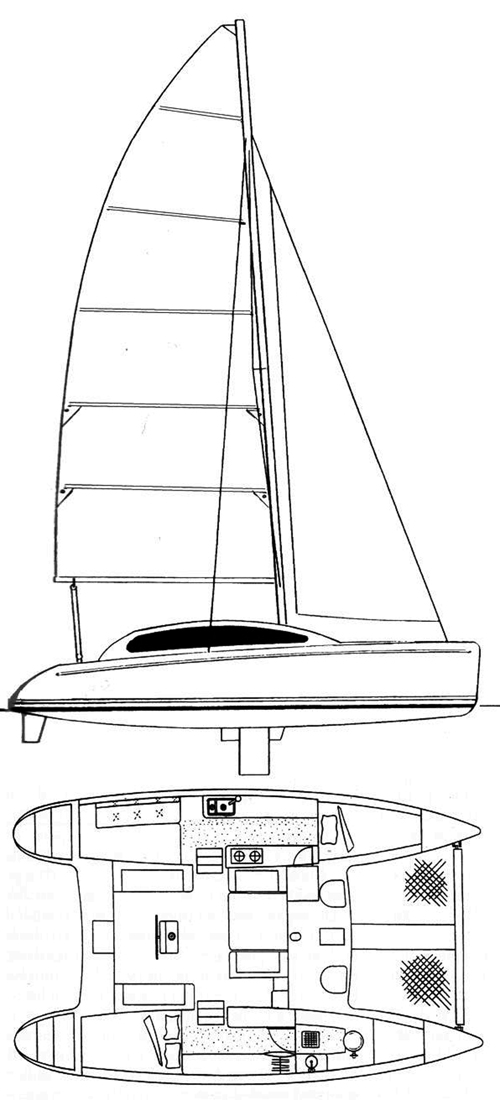The Maine Cat, a Small Liveaboard or Weekender Performance Catamaran

Maine Cat, an abbreviated history
The Maine Cat boat building company was started in 1991 by owner and in-house yacht designer, Dick Vermeulen. The company is located in Lincolnville, ME, on West Penobscot Bay and at last count employs 17 people. The emphasis is on limited production, quality built semi-custom power and sailing catamarans; the sailing models currently offered are the Maine Cat 30, Maine Cat 38, and Maine Cat 41.
Maine Cat 30
The Maine Cat 30 was introduced in 1996 as a competitively priced small liveaboard or weekender performance catamaran. According to the company website the MC 30 is still in production. With the standard factory equipment, the initial impression is one of a “generic” catamaran, if such a thing exists.
The layout is simple and relatively predictable given the space available. The head room throughout the vessel interior is sufficient for most, reportedly at six feet, three inches tall. The vessel is equipped with a full head compartment in the starboard bow, a basic galley in the middle of the port hull, and full-time dedicated berthing below decks for five. Double berths were located at the aft end of each hull with a smaller berth located in the port bow.
The main dining/sitting area is in the raised mid-deck area between the two hulls with a hard top over a large portion of the mid-deck area. This is an open-air environment with wind and rain protection provided with eisenglass panels. A hard-sided version of the cockpit area is reportedly available, but I have not been able to locate any pictures or official mention.
The MC 30 is driven by twin nine-horsepower, four-stroke electric start outboards located under the port and starboard cockpit seats. The outboards can be electrically trimmed up to reduce drag while under sail or when docked. One unique design feature of the MC 30 is the lopsided installation of a single daggerboard in the starboard hull for improving windward performance under sail but with a meager two-foot draft with the board up, ideal for anchoring and exploring where most mono-hulls cannot.
The exterior and interior of the MC 30 are coated with white gelcoat with very little interior trim and basic soft wares resulting in a practical and easy-to-clean cabin albeit with a rather “institutional” ambiance. The lamination and gelcoat quality, in my opinion, is considered above average; exterior and interior surfaces appear to have aged well considering the subject vessel was more than 20 years old.
Considerations and observations
Very few age-related issues such as moisture intrusion into hull coring or gelcoat crazing were noted.
Although described as “generic,” the workmanship quality is considered above average for a production sailboat manufacture. This is not immediately evident as there is very little polished joinery to catch the eye.
Windward performance, especially with the board down, was above average; however, getting good trim on the jib was challenging.
The AC and DC electrical systems are “basic” with an on/off battery switch connected to a single battery for both house use and engine starting. One downside to the use of outboards is the low charging outputs of small outboard engines, something to consider if cruising with prolonged use of sailing instruments and DC refrigeration; one solution is the installation of multiple solar panels on the spacious hard top.
Vessel did not come properly equipped with navigation lights; the stock factory set up in the 2002 version was technically not to USCG standards—this used to be a common observation with other catamaran builders as well.
There is no rub rail installed to protect the topsides from damage, a pet peeve of mine with other catamarans.
The beam is wide, 18 feet, considering the LOA. This limits dockage and haul-out options.
Specifications
L.O.A.: 30'
Beam: 18'
Draft: 2' (board up); 5' (board down)
Displacement: 6000 lbs
Designer: Dick Vermeulen
Builder: Maine Cat
Availability
As of January 1, 2022, there was only one available in the U.S. starting at $139,500.00. Recent purchase histories suggest selling prices between $139,000 and $150,000 depending on equipment.
by Captain Tarn Kelsey
About the author: Capt.Tarn Kelsey owns and operates Kelsey Marine Survey in Annapolis.




